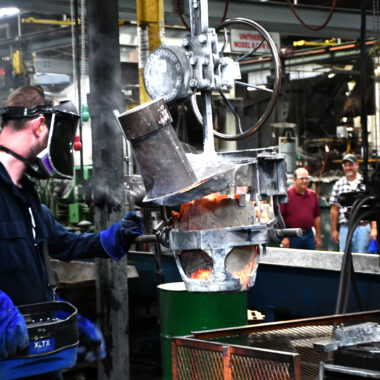Crafting Excellence: Just How to Attain High-Quality Light Weight Aluminum Castings Every Single Time
In the world of light weight aluminum spreading, the quest of perfection is a continuous journey that requires a precise method and a keen understanding of the details involved. Attaining constant high-grade light weight aluminum castings requires a detailed grasp of the procedures, from choosing the suitable alloy to performing precise mold designs and meticulously regulating spreading specifications. The real proficiency lies in the capability to implement these aspects perfectly to develop flawless spreadings every time. As we explore the ins and outs of crafting perfection in aluminum spreadings, uncovering the vital techniques and strategies that result in impeccable outcomes comes to be vital for those striving for quality in this specialized area.
Recognizing Aluminum Casting Processes
Aluminum casting processes, important in the production market, include the complex makeover of liquified light weight aluminum into solid forms through a collection of very carefully regulated actions. Comprehending these procedures is vital to attaining high-quality aluminum spreadings continually - about aluminum casting. The key methods made use of in light weight aluminum spreading are die casting, sand casting, and investment spreading

Each of these procedures has its benefits and is picked based upon factors like complexity, volume, and preferred surface of the aluminum spreading. about aluminum casting. Recognizing the ins and outs of these approaches is important for suppliers aiming to create high-quality aluminum castings constantly
Picking the Right Aluminum Alloy
Selecting the proper aluminum alloy is an important decision in the production of high-quality aluminum spreadings. When selecting an aluminum alloy for spreading, it is important to consider the particular needs of the application to make sure optimum efficiency.
Among the most frequently made use of aluminum alloys for casting is A356. This alloy supplies excellent castability, high stamina, and great deterioration resistance, making it suitable for a wide variety of applications. 6061 light weight aluminum alloy is preferred for its exceptional weldability and great mechanical buildings. For applications calling for high strength, 7075 aluminum alloy is a popular option because of its outstanding strength-to-weight ratio.
In enhancement to mechanical residential properties, factors to consider such as price, schedule, and post-casting procedures must likewise affect the choice of the ideal light weight aluminum alloy. By very carefully reviewing these aspects, makers can make certain the manufacturing of top quality aluminum spreadings that satisfy the preferred specifications.
Executing Proper Mold And Mildew Layout
Establishing an efficient mold layout is vital for making sure the successful production of high-grade light weight aluminum castings. Proper mold and mildew design plays a significant duty in accomplishing the wanted features of the last product. To implement an effective mold design, variables such as material circulation, cooling down rates, and component geometry should be meticulously taken into consideration.
One secret aspect of mold and mildew look here design is making certain appropriate dental filling and solidification of the aluminum within the mold and mildew tooth cavity. This involves creating runner and gating systems that promote smooth metal circulation and stop flaws such as air entrapment or incomplete filling. In addition, integrating cooling channels right into the mold and mildew design assists control solidification prices and lower the danger of porosity or shrinkage issues.

Controlling Casting Parameters

Making Certain Post-Casting High Quality Checks
To maintain the high this post quality of aluminum spreadings, extensive post-casting top quality checks are necessary. After the spreading process is completed, it is essential to make certain that the last products satisfy the wanted specs and criteria.
Dimensional accuracy is another essential facet that needs to be validated during post-casting top quality checks. Measurements of essential measurements and tolerances must be required to validate that the spreadings adjust to the needed specs. Furthermore, mechanical residential properties such as solidity, tensile stamina, and influence resistance might need to be reviewed through product screening to make sure that the spreadings have the necessary toughness and sturdiness for their desired application.
Verdict
Finally, accomplishing high-quality aluminum castings needs a thorough understanding of the casting processes, selecting the proper alloy, creating molds effectively, controlling casting criteria thoroughly, and carrying out post-casting top quality checks diligently. By adhering to these steps, producers can constantly produce light weight aluminum spreadings that satisfy the highest possible standards of top quality and performance.
Attaining constant high-quality aluminum content castings requires a thorough understanding of the procedures, from picking the proper alloy to implementing specific mold and mildew designs and carefully regulating casting specifications. The primary approaches utilized in light weight aluminum spreading are pass away spreading, sand spreading, and investment casting.
Investment casting, likewise recognized as precision casting, includes producing wax patterns that are coated in ceramic to create mold and mildews.Picking the ideal aluminum alloy is a vital choice in the production of premium aluminum spreadings.Guaranteeing specific control over casting parameters is essential for maintaining uniformity and top quality in aluminum casting production.